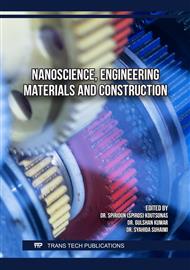[1]
Kulasooriya W, Ranasinghe R S S, Perera U S, et al. Modeling strength characteristics of basalt fiber reinforced concrete using multiple explainable machine learning with a graphical user interface[J]. Scientific Reports, 2023, 13(1): 13138.
DOI: 10.1038/s41598-023-40513-x
Google Scholar
[2]
Almasabha G, Al-Shboul K F, Shehadeh A, et al. Machine learning-based models for predicting the shear strength of synthetic fiber reinforced concrete beams without stirrups[C]//Structures. Elsevier, 2023, 52: 299-311.
DOI: 10.1016/j.istruc.2023.03.170
Google Scholar
[3]
Golewski G L. The phenomenon of cracking in cement concretes and reinforced concrete structures: the mechanism of cracks formation, causes of their initiation, types and places of occurrence, and methods of detection—a review[J]. Buildings, 2023, 13(3): 765.
DOI: 10.3390/buildings13030765
Google Scholar
[4]
Hailong W, Weiliang J, Xiaoyan S. Rust expansion cracking model of reinforced concrete protective layer based on fracture mechanics. J HYDRAUL ENG 2008;39(7):7.
Google Scholar
[5]
Licheng W, Shaoyun W. Mechanism of crack opening and self-healing of concrete. J HYDRAUL ENG 2019(7):11.
Google Scholar
[6]
Yao Z, Kejing Y, Kun Q. Surface modification and interface effect of basalt fiber. Journal of Materials Science and Engineering 2019;37(4):7.
Google Scholar
[7]
Li Y, Zhang J, He Y, et al. A review on durability of basalt fiber reinforced concrete[J]. Composites Science and Technology, 2022, 225: 109519.
DOI: 10.1016/j.compscitech.2022.109519
Google Scholar
[8]
Jinyong W, Lina L, Shenyuan F. Research progress on tribological properties of fiber-reinforced EP composites. Engineering plastics application 2019;47(3).
Google Scholar
[9]
Tosun-Feleko Lu K, Feleko Lu B, Ranade R, Lee BY, Li VC. The role of flaw size and fiber distribution on tensile ductility of PVA-ECC. Composites Part B Engineering 2014;56:536-45.
DOI: 10.1016/j.compositesb.2013.08.089
Google Scholar
[10]
Mehmet, Emin, Arslan. Effects of basalt and glass chopped fibers addition on fracture energy and mechanical properties of ordinary concrete: CMOD measurement. Construction & Building Materials 2016.
DOI: 10.1016/j.conbuildmat.2016.03.176
Google Scholar
[11]
Ren D, Luo W, Su S, et al. Study on crack resistance of basalt fiber reinforced asphalt mixture modified by titanate coupling agent based on digital image correlation[J]. Construction and Building Materials, 2024, 437: 136934.
DOI: 10.1016/j.conbuildmat.2024.136934
Google Scholar
[12]
Tingting J, Shijie S, Jing L, Shuping Z. Effect of low temperature plasma treatment on basalt fiber surface and properties of composite materials. Composite materials 2015(6):7.
Google Scholar
[13]
Yong T, Dynasty SJ, Wenjing H. Research on surface modification of basalt fiber and its application in concrete environment. Plating and finishing 2020;42(10):7.
Google Scholar
[14]
Lee SO, Rhee KY, Park SJ. Influence of chemical surface treatment of basalt fibers on interlaminar shear strength and fracture toughness of epoxy-based composites. Journal of Industrial & Engineering Chemistry 2015;32(Complete):153-6.
DOI: 10.1016/j.jiec.2015.08.009
Google Scholar
[15]
Shuqiang L, Wujie, Gaihong W, Xiaolong Y, Fu L, Man Z. Surface modification of basalt fiber by nano-sio2. Journal of Textile Science 2020(012):41.
Google Scholar
[16]
Kim MT, Kim MH, Rhee KY, Park SJ. Study on an oxygen plasma treatment of a basalt fiber and its effect on the interlaminar fracture property of basalt/epoxy woven composites. Composites Part B Engineering 2011;42(3):499-504.
DOI: 10.1016/j.compositesb.2010.12.001
Google Scholar
[17]
Songmei B, Qinqin Z, Kun Z, Huang CP. Effect of plasma modification on properties of basalt/polypropylene composites. Industrial textiles 2013(06):32-5.
Google Scholar
[18]
Junjie W. Study on surface nanoregulation of basalt fiber and its mechanical and tribological properties: North University of China; 2018.
Google Scholar
[19]
Guorui Y. Properties of graphene oxide modified basalt fiber and reinforced epoxy resin composites. J COMPOS MATER 2014.
Google Scholar
[20]
Cheng X, Liu J, Han C, et al. Silane coupling agent impact on surface features of modification of basalt fibers and the rheological properties of basalt fiber reinforced asphalt[J]. Construction and Building Materials, 2023, 366: 130182.
DOI: 10.1016/j.conbuildmat.2022.130182
Google Scholar
[21]
Xiaodong. W, Wansning, Taihong Z, Bong YH, Delong X. Research progress of basalt fiber reinforced composites modified by silane coupling agent. Material guide 2017;031(005):77-83.
Google Scholar
[22]
Yunhua Z. Mechanical properties of surface treated basalt fiber reinforced cement-based composites. J COMPOS MATER 2017;34(5):8.
Google Scholar
[23]
Ren D, Wang Z, Xu J, et al. Microscopic mechanisms and chloride resistance performance of silane coupling agent self-assembly on reinforced concrete utilizing X-ray CT technology: A comprehensive investigation[J]. Journal of Building Engineering, 2023, 80: 107992.
DOI: 10.1016/j.jobe.2023.107992
Google Scholar
[24]
Bhosale AB, Shanmugam SP. Crack Propagation Analysis of Synthetic Vs. Steel Vs. Hybrid Fibre Reinforced Concrete Beams using Digital Image Correlation Technique. INT J CONCR STRUCT M 2020;14(57):1-19.
DOI: 10.1186/s40069-020-00427-8
Google Scholar
[25]
Liu F, Ding W, Qiao Y. Experimental investigation on the tensile behavior of hybrid steel-PVA fiber reinforced concrete containing fly ash and slag powder. CONSTR BUILD MATER 2020;241:118000.
DOI: 10.1016/j.conbuildmat.2020.118000
Google Scholar
[26]
Jia H, Liu C, Qiao Y, Zhang Y, Jian X. Enhanced interfacial and mechanical properties of basalt fiber reinforced poly(aryl ether nitrile ketone) composites by amino-silane coupling agents. POLYMER 2021:124028.
DOI: 10.1016/j.polymer.2021.124028
Google Scholar
[27]
Iorio M, Santarelli ML, González-Gaitano G, González-Benito J. Surface modification and characterization of basalt fibers as potential reinforcement of concretes. APPL SURF SCI 2018;427(pt.a):1248-56.
DOI: 10.1016/j.apsusc.2017.08.196
Google Scholar
[28]
Ren D, Su S, Wang Z, et al. Multi-scale investigation of silane coupling agent for enhanced corrosion resistance in reinforced concrete[J]. Construction and Building Materials, 2024, 442: 137653.
DOI: 10.1016/j.conbuildmat.2024.137653
Google Scholar
[29]
Wang Q, Ding Y, Randl N. Investigation on the alkali resistance of basalt fiber and its textile in different alkaline environments. CONSTR BUILD MATER 2020;272(11):121670.
DOI: 10.1016/j.conbuildmat.2020.121670
Google Scholar
[30]
Shengen F, Peihui Z, Honghua. Formula of bending test and cracking moment of fiber reinforced concrete beam. Journal of building materials 2019; 22(4):8.
Google Scholar


